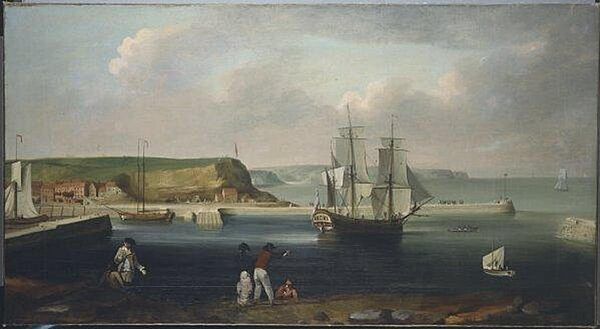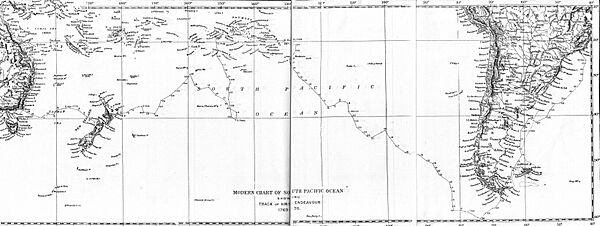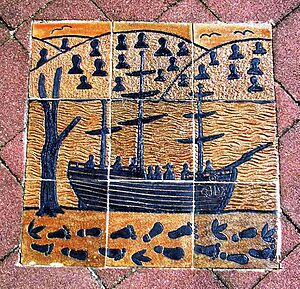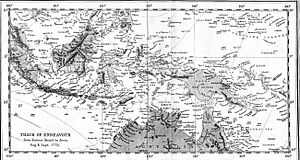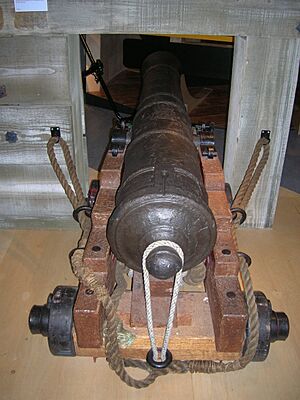HMS Endeavour facts for kids

HMS Endeavour off the coast of New Holland
by Samuel Atkins |
|
Quick facts for kids History |
|
|---|---|
| Name | Endeavour |
| Operator | Thomas Millner, Royal Navy, J. Mather |
| Builder | Thomas Fishburn, Whitby |
| Launched | June 1764 |
| Acquired | 28 March 1768 as Earl of Pembroke |
| Commissioned | 26 May 1768 |
| Decommissioned | September 1774 |
| Out of service | March 1775, sold |
| Renamed | Lord Sandwich, February 1776 |
| Homeport | Plymouth, United Kingdom |
| Fate | Scuttled, Newport, Rhode Island, 1778 |
| General characteristics | |
| Class and type | Bark |
| Tons burthen | 366 49⁄94 (bm) |
| Length | 97 ft 8 in (29.77 m) |
| Beam | 29 ft 2 in (8.89 m) |
| Depth of hold | 11 ft 4 in (3.45 m) |
| Sail plan |
|
| Speed | 7 to 8 knots (13 to 15 km/h) maximum |
| Boats & landing craft carried |
yawl, pinnace, longboat, two skiffs |
| Complement |
|
| Armament | 10 4-pdrs, 12 swivel guns |
HMS Endeavour was a famous British Royal Navy research vessel. From 1768 to 1771, Lieutenant James Cook commanded her on his first voyage of discovery. During this trip, she sailed to Tahiti, New Zealand, and Australia.
The ship was first launched in 1764 as a collier (a ship that carries coal) named Earl of Pembroke. The Navy bought her in 1768 for a scientific mission to the Pacific Ocean. They also wanted to explore the seas for a rumored "unknown southern land" called Terra Australis Incognita. Renamed His Majesty's Bark Endeavour, she left Plymouth in August 1768. She sailed around Cape Horn and reached Tahiti in time to watch the 1769 transit of Venus (when Venus passes in front of the Sun).
After Tahiti, Endeavour explored the mostly unknown southern ocean. She stopped at islands like Huahine, Bora Bora, and Raiatea, where Cook claimed them for Great Britain. In September 1769, she became the first European ship to reach New Zealand since Abel Tasman's Heemskerck 127 years earlier. In April 1770, Endeavour was the first European ship to reach the east coast of Australia. Cook landed at what is now Botany Bay.
Endeavour then sailed north along the Australian coast. She almost sank after hitting the Great Barrier Reef. Cook had to throw her guns overboard to make her lighter. The ship was pulled onto the Australian mainland for seven weeks to fix her hull. She then slowly sailed to Batavia (now Jakarta) in October 1770. Her crew had to keep their discoveries a secret. From Batavia, Endeavour continued west, rounded the Cape of Good Hope on March 13, 1771, and reached Dover, England, on July 12. The voyage had lasted almost three years.
After her Pacific journey, the ship was mostly forgotten. For the next three years, she carried troops and supplies to the Falkland Islands. In 1775, she was sold to private owners and renamed. She was used to carry timber from the Baltic Sea. Later, during the American War of Independence, she was hired again by the British to transport troops. In 1778, she was finally sunk on purpose in a blockade of Narragansett Bay, Rhode Island. Historical records show she was sunk near Goat Island in Newport Harbor, along with four other British transport ships.
Today, parts of Endeavour are in museums around the world, including an anchor and six of her cannons. A replica of Endeavour was launched in 1994. It is now docked next to the Australian National Maritime Museum in Sydney Harbour. Many places are named after the ship, like the Endeavour River and Endeavour Reef. Three spacecraft were also named after her. The ship is even shown on the New Zealand fifty-cent coin.
Contents
Building a Famous Ship: The Endeavour Story
Endeavour was originally a merchant ship called Earl of Pembroke. She was built by Thomas Fishburn in June 1764 in Whitby, England. This area was known for coal shipping and whaling. She was a type of ship called a "Whitby Cat".
The ship was built to be very strong. She had a wide, flat front (bow) and a square back (stern). Her long, box-like body had a deep hold for cargo. This flat-bottomed design was great for sailing in shallow waters. It also allowed her to be pulled onto a beach for loading, unloading, or simple repairs without needing a dry dock.
Her main parts, like the hull and internal supports, were made from strong white oak. The main beam (keel) and back post were made from elm. Her masts were built from pine and fir. The ship's plans also show a double keelson, which helped hold the keel and frames firmly in place.
Getting Ready for Discovery: The Admiralty's Refit
In February 1768, a group of scientists called the Royal Society asked King George III to pay for a trip to the Pacific. They wanted to study the 1769 transit of Venus (when Venus passes across the Sun). The King agreed. The Admiralty (the part of the government that managed the navy) decided to add a secret mission. They wanted to search the South Pacific for a rumored continent, Terra Australis Incognita (the "unknown southern land").
The Royal Society wanted a geographer named Alexander Dalrymple to lead the trip. But he wanted to be a captain in the Royal Navy, even though he wasn't a trained sailor. The head of the Admiralty, Edward Hawke, refused. He said he would rather cut off his hand than let a non-sailor command a navy ship. This was because of past problems when naval officers didn't obey civilian commanders.
To solve this, the Admiralty suggested James Cook. He was a naval officer who was also good at math and making maps. Both sides agreed. Cook was promoted to lieutenant and chosen to lead the expedition.
On May 27, 1768, Cook took command of the Earl of Pembroke. The Navy bought her for about £2,840. She was then taken to Deptford Dockyard on the River Thames for major changes. These repairs cost almost as much as the ship itself!
The hull was sealed again and covered with copper. This protected it from shipworms. A third deck was added inside to create cabins, a place for gunpowder, and storage rooms. Cook and the Royal Society scientists got their own cabins. These included naturalist Joseph Banks, his assistants, an astronomer, and artists. These cabins were around the officers' dining area. The large cabin at the back was a workspace for Cook and the scientists.
The ship also got three smaller boats: a longboat, a pinnace, and a yawl. The longboat had to be rebuilt because it was rotten. The ship was also given long oars called sweeps. These would help move the ship if there was no wind or if her masts were broken. After these changes, the ship was named His Majesty's Bark the Endeavour. This helped tell her apart from another navy ship called HMS Endeavour.
On July 21, 1768, Endeavour sailed to take on weapons. These were for protection against potentially unfriendly Pacific islanders. Ten small cannons were brought aboard, and twelve smaller swivel guns were also added. The ship then left for Plymouth on July 30. There, she took on supplies and a crew of 85, including 12 Royal Marines. Cook also ordered 12 tons of pig iron to be added as sailing ballast to help stabilize the ship.
The Great Voyage of Discovery
Leaving England and Heading South
Endeavour left Plymouth on August 26, 1768. She carried 18 months of food for 94 people. They also had livestock like pigs, chickens, two greyhounds, and a milking goat.
Their first stop was Funchal in the Madeira Islands on September 12. The ship was repaired and painted. They took on fresh vegetables, beef, and water for the next part of the trip. Sadly, a crew member died here when he got caught in the anchor rope. Cook had to find a new sailor from another ship.
Endeavour then sailed south along Africa's coast and across the Atlantic to South America. They arrived in Rio de Janeiro on November 13, 1768. After getting more food and water, they left for Cape Horn. They reached this stormy area on January 13, 1769. For two days, strong winds and rain pushed them back. Cook noted how huge the waves were. Finally, on January 16, the wind calmed, and they passed the Cape. They anchored in the Bay of Good Success on the Pacific coast. The crew collected wood and water. Joseph Banks and his team found hundreds of plant samples. Sadly, two of Banks' servants died from the cold trying to get back to the ship in a snowstorm.
Endeavour continued her journey on January 21, 1769, heading northwest into warmer weather. She reached Tahiti on April 10 and stayed for three months. The main event was the transit of Venus across the Sun on June 3. Astronomer Charles Green watched and recorded it from the ship's deck.
Exploring the Pacific Ocean
After observing Venus, Endeavour left Tahiti on July 13. Cook sailed northwest to map and name the Society Islands. They landed at Huahine, Raiatea, and Borabora. Cook claimed each of these islands for Britain. They tried to land a small boat on the Austral Island of Rurutu, but rough waves stopped them. On August 15, Endeavour finally turned south to search the open ocean for the "unknown southern land."
In October 1769, Endeavour reached New Zealand. This was the first time a European ship had been there since Abel Tasman's Heemskerck in 1642. The Māori people at Cook's first landing spot thought the ship was a floating island or a giant bird. Endeavour spent the next six months sailing close to shore. Cook mapped the coastline and realized New Zealand was two large islands, not the continent they hoped for. In March 1770, Cook went ashore in the longboat to officially claim New Zealand for Britain.
After that, Endeavour sailed west. On April 19, her crew saw the east coast of Australia. On April 29, she became the first European ship to land on Australia's east coast. Cook landed a boat on the southern shore of what is now Botany Bay, New South Wales.
Shipwreck on the Great Barrier Reef
For the next four months, Cook mapped the coast of Australia, heading north. Just before 11:00 pm on June 11, 1770, the ship hit a reef. Today, this is called Endeavour Reef, part of the Great Barrier Reef. The crew quickly lowered the sails and tried to pull the ship back to open water, but it was stuck. The reef rose so steeply that the ship was aground, but very deep water was just a short distance away.
Cook ordered the ship to be made lighter to help it float off the reef. They threw iron and stone ballast, spoiled food, and all but four of the ship's guns overboard. They also pumped out the drinking water. They tied buoys to the discarded guns, hoping to get them back later, but this didn't happen. Everyone on board, including Cook and Banks, took turns pumping water out of the ship.
After throwing about 40 to 50 tons of equipment overboard, they tried again to pull the ship free at the next high tide, but failed. On the afternoon of June 12, the longboat carried two large anchors far out. Ropes and pulleys were set up to the anchor chains for another try at the evening high tide. The ship had a hole and was taking on water. Even though the leak would get worse, Cook decided to risk it. At 10:20 pm, the ship floated on the tide and was successfully pulled off the reef. They got the anchors back, except for one that was stuck and had to be left behind.
As expected, the leak got worse once the ship was off the reef. All three pumps had to be worked constantly. A mistake was made when measuring the water in the hold, causing a moment of panic. But once the mistake was found, the crew worked even harder and kept the pumps ahead of the leak.
If the ship sank, the situation would be terrible. They were 24 miles from shore, and the three small boats couldn't carry everyone. Despite this, Banks wrote in his journal that the crew remained calm and efficient, which was unusual in such danger.
A young officer named Jonathon Monkhouse suggested a method called fothering the ship. He had seen it work before. He supervised sewing bits of oakum (loose fibers) and wool into an old sail. This sail was then pulled under the ship. The water pressure pushed the sail into the hole, plugging it. This worked, and soon very little water was coming in. The crew could stop two of the three pumps.
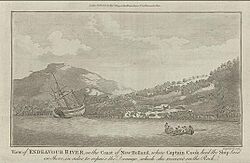
Endeavour then continued north, sailing parallel to the reef. The crew looked for a safe harbor to make repairs. On June 13, the ship found a wide river, which Cook named the Endeavour River. Cook tried to enter the river, but strong winds and rain stopped Endeavour from crossing the sandbar until June 17. She briefly got stuck on a sand spit but was freed an hour later. By early afternoon, she was pulled into the river. The ship was quickly pulled onto the southern bank and tilted to one side for hull repairs. Torn sails and ropes were also replaced, and the hull was cleaned of barnacles.
An inspection of the hull showed that a piece of coral, about the size of a man's fist, had cut cleanly through the wood before breaking off. This coral piece, surrounded by the oakum from the fothering, had helped plug the hole. It saved the ship from sinking on the reef.
Sailing to Batavia and Home
After waiting for the wind, Endeavour continued her voyage on August 5, 1770. Fifteen days later, she reached the northernmost point of Cape York Peninsula. On August 22, Cook went ashore to a small island. He officially claimed the eastern Australian mainland for Britain. Cook named his landing place Possession Island. Ceremonial gunshots from the shore and Endeavour's deck marked the occasion.
Endeavour then sailed west along the coast. She carefully navigated through reefs and shallow areas, with a small boat rowing ahead to check the water depth. By August 26, she was out of sight of land. She had entered the open waters of the Torres Strait, between Australia and New Guinea. To keep Endeavour's discoveries secret, Cook took everyone's log books and journals. He ordered them not to talk about where they had been.
After a three-day stop near the island of Savu, Endeavour sailed to Batavia (now Jakarta), the capital of the Dutch East Indies, on October 10. The next day, lightning struck the ship during a sudden storm. But a simple "electric chain" or lightning rod that Cook had put on Endeavour's mast saved her from serious damage.
The ship was in very bad shape after hitting the Great Barrier Reef in June. The ship's carpenter noted she was "very leaky." An inspection showed that some unrepaired planks were cut almost all the way through. Cook wrote that it was a "surprise to every one who saw her bottom how we had kept her above water" for the past three months.
After two weeks, Endeavour was pulled out of the water on November 9 and tilted on her side for repairs. Some damaged timbers were full of shipworms, which had to be carefully removed. Broken wood was replaced, and the hull was sealed, cleaned of shellfish, and repainted. Finally, the ropes and pumps were fixed, and fresh supplies were brought aboard for the trip back to England. Repairs were finished by Christmas Day 1770. The next day, Endeavour set sail west towards the Indian Ocean.
The Journey Home
Even though Endeavour was now in good condition, her crew was not. While in Batavia, almost everyone (all but 10 of 94 people) got sick with malaria and dysentery. By the time Endeavour sailed on December 26, seven crew members had died. Another forty were too sick to work. Over the next twelve weeks, 23 more died from disease and were buried at sea. This included important scientists like Spöring, Green, and Parkinson, and the ship's doctor.
Cook thought the sickness was from bad drinking water. He ordered it to be cleaned with lime juice, but it didn't help much. The health of the remaining crew slowly got better as the month went on. The last deaths from disease were three sailors on February 27.
On March 13, 1771, Endeavour sailed around the Cape of Good Hope. She reached Cape Town two days later. Those who were still sick were taken ashore for treatment. The ship stayed in port for four weeks while the crew recovered and minor repairs were made to her masts. On April 15, the sick crew members came back aboard, along with ten new recruits from Cape Town. Endeavour then continued her journey home. The English mainland was seen on July 10, and Endeavour entered the port of Dover two days later.
About a month after his return, Cook was promoted to commander. By November 1771, he was given orders for a second expedition, this time on HMS Resolution. During his third voyage, Cook was killed in Hawaii in 1779.
Endeavour After Cook's Voyage
After Cook's famous journey, Endeavour was largely forgotten. Within a week of her return to England, she was sent to Woolwich Dockyard to be changed into a naval transport ship. Under Lieutenant James Gordon, she made three trips to the Falkland Islands.
Her first trip was to deliver supplies for 350 men. She sailed from Portsmouth in November 1771. Bad weather meant she didn't arrive until March 1772. She then sailed back to Portsmouth in a three-month non-stop journey.
The second trip was to reduce the number of soldiers there and replace a larger ship with a smaller one. Endeavour carried a collapsible boat called Penguin. It was taken apart and stored on Endeavour, then put back together when they arrived in January 1773.
The third trip, in January 1774, was to completely evacuate the Falklands. Britain was having problems with its American Colonies, France, and Spain. The government feared that if British ships were busy in America, Spain might take the Falklands. Endeavour left the Falklands with all British residents on April 23, leaving behind a flag and plaque to show Britain still claimed the islands.
Endeavour was taken out of naval service in September 1774. In March 1775, the Royal Navy sold her to a shipping owner named J. Mather for £645. Mather used her for at least one commercial trip to Russia.
When the American War of Independence began, the British government needed ships to carry troops and supplies. In 1775, Mather offered Endeavour as a transport ship, but she was rejected. Thinking he could trick them, Mather offered her again under the name Lord Sandwich. She was rejected again, with a note saying: "Unfit for service. She was sold out Service Called Endeavour Bark refused before." After repairs, she was finally accepted on her third try, named Lord Sandwich 2 because there was already a ship called Lord Sandwich.
Lord Sandwich 2 sailed on May 6, 1776, from Portsmouth. She was part of a large fleet of 100 ships, mostly transports, sent to help capture New York. Lord Sandwich 2 carried 206 soldiers, mainly German mercenaries. The journey was stormy. The fleet gathered at Halifax, then sailed to Sandy Hook. Other ships, including Adventure (which had sailed with Cook on his second voyage), were also there.
New York was captured, but Newport, Rhode Island, was still held by the Americans. It was a threat to New York. So, in November 1776, a fleet, including Lord Sandwich 2 carrying German troops, set out to take Rhode Island. The island was taken, and Lord Sandwich 2 was used as a prison ship.
The Final Resting Place of Endeavour
When the British army surrendered at Saratoga, France joined the war. In the summer of 1778, a plan was made to recapture Newport. The American army would attack by land, and a French fleet would sail into the harbor. To stop the French fleet, the British commander decided to block the bay by sinking extra ships at its entrance. Between August 3 and 6, several Royal Navy and hired ships, including Lord Sandwich 2, were sunk in different places in the Bay. Lord Sandwich 2, which was once Endeavour, was sunk on August 4, 1778.
The British government paid the owners of the sunken ships for their loss. Records for 10 of the sunken ships showed that many were built in Yorkshire. The details for the Lord Sandwich transport matched those of the former Endeavour. This included being built in Whitby, weighing 368 tons, and rejoining Navy service on February 10, 1776.
In 1991, the Rhode Island Marine Archaeology Project (RIMAP) began looking into the identity of the thirteen transport ships sunk in the Newport blockade of 1778. This included Lord Sandwich. In 1999, RIMAP found documents in London that confirmed Endeavour had been renamed Lord Sandwich. It also confirmed she had carried troops to North America and was sunk at Newport in 1778.
In 1999, a team from RIMAP and the Australian National Maritime Museum (ANMM) examined some known shipwrecks in the harbor. In 2000, they looked at a site that seemed to be one of the blockade ships. It was partly covered by a sunken barge from the 20th century. The older remains were from a wooden ship about the same size and possibly design as Lord Sandwich (the former Endeavour).
Finding out that Cook's old ship was likely in Newport Harbor made people very interested in finding her wreck. However, further mapping showed eight other 18th-century wrecks in Newport Harbor. Some of these also matched Endeavour's features. In 2006, RIMAP said it was unlikely the wrecks would be raised. In 2016, RIMAP concluded there was an 80 to 100% chance that the wreck of Endeavour was still in Newport Harbor. It was probably one of a group of five wrecks on the seabed. They planned to study the ships and their artifacts more.
In September 2018, news reported that RIMAP archaeologists had found the ship's final resting place. This possible discovery was called a "hugely significant moment" in Australian history. But researchers warned they still needed to "definitively" confirm it.
On February 3, 2022, the ANMM announced that the wreck had been confirmed as the Endeavour. However, RIMAP called the announcement "premature" and a "breach of contract." The ANMM denied this. RIMAP's lead investigator said that "no indisputable data" had been found to prove the site was the Endeavour. She added that "many unanswered questions" could change the identification. In November 2023, the ANMM announced more confirming discoveries. Meanwhile, the wreck is being eaten by shipworms and gribbles.

Endeavour Relics and Legacy
People in Australia were very interested in finding parts of the ship from its South Pacific voyage. In 1886, a group in Cooktown tried to find the six cannons that were thrown overboard when Endeavour hit the Great Barrier Reef. A reward of £300 was offered, but searches in 1886 and 1887 found nothing. Parts of equipment left at Endeavour River were found around 1900. In 1913, a merchant ship crew wrongly claimed to have found an Endeavour cannon.
In 1937, a small piece of Endeavour's keel (the main bottom beam) was given to the Australian Government. Australian Prime Minister Joseph Lyons said this piece of keel was "closely connected with the discovery and founding of Australia."
Searches for the lost Endeavour Reef cannons started again. Expeditions in 1966, 1967, and 1968 were not successful. They were finally found in 1969 by a research team using a special device called a magnetometer. They found the cannons and some iron ballast, but not the lost anchor. The cannons were cleaned and preserved by the Australian National Maritime Museum. Two are displayed in Sydney, and one is in Canberra. A third cannon and an anchor found in 1971 are in the James Cook Museum in Cooktown. The other three cannons are in museums in London, Philadelphia, and Wellington (New Zealand).
Endeavour's Pacific voyage is also remembered on the back of the New Zealand fifty-cent coin.
The Apollo 15 spacecraft's command module was named Endeavour. Astronaut David Scott said they chose the name because Captain Cook led the first purely scientific sea voyage. Apollo 15 was the first moon landing mission focused heavily on science. Apollo 15 even took a small piece of wood said to be from Cook's ship into space. The ship was honored again in 1989 when the Space Shuttle Endeavour was named after her. The shuttle's name then inspired the naming of the SpaceX Crew Dragon Endeavour, the first capsule to launch crew.
Replica Ships: Keeping the Endeavour Story Alive

In January 1988, work began in Fremantle, Western Australia, to build a replica of Endeavour. This was to celebrate 200 years since European settlement in Australia. Money problems delayed the project until December 1993. The ship was officially ready in April 1994. The replica's first voyage was in October that year. She sailed to Sydney Harbour and then followed Cook's path north to Cooktown. From 1996 to 2002, the replica visited Cook's stops around the world. She arrived in Endeavour's original home port of Whitby in May 1997 and June 2002. Videos of waves from rounding Cape Horn on this trip were used in the 2003 movie Master and Commander: The Far Side of the World.
The replica Endeavour visited several European ports. Her final ocean voyage was from Whitehaven to Sydney Harbour on November 8, 2004. Her arrival in Sydney was delayed when she ran aground in Botany Bay. This was near where Cook first landed in Australia 235 years earlier. The replica Endeavour finally entered Sydney Harbour on April 17, 2005. She had traveled 170,000 nautical miles, including twice around the world. Ownership of the replica was given to the Australian National Maritime Museum in 2005. She now serves permanently as a museum ship in Sydney's Darling Harbour.
A second full-size replica of Endeavour was docked on the River Tees in Stockton-on-Tees before moving to Whitby. This replica looks like Cook's ship from the outside. However, it has a steel frame instead of wood and one less deck inside. It is not designed to sail at sea.
The Russell Museum in New Zealand has a sailing replica of Endeavour that is one-fifth the original size. It was built in Auckland in 1969. It traveled around New Zealand and Australia by trailer before being given to the museum in 1970.
In Whitby, the "Bark Endeavour Whitby" is a smaller replica of the original ship. It uses engines to move and is less than half the size of the original. Tourist trips take visitors along the coast.
A 25-foot replica of the ship is displayed in the Cleveland Centre in Middlesbrough, England.
See also
 In Spanish: HMB Endeavour para niños
In Spanish: HMB Endeavour para niños
- Blue Latitudes, a travel book by Tony Horwitz
- European and American voyages of scientific exploration


